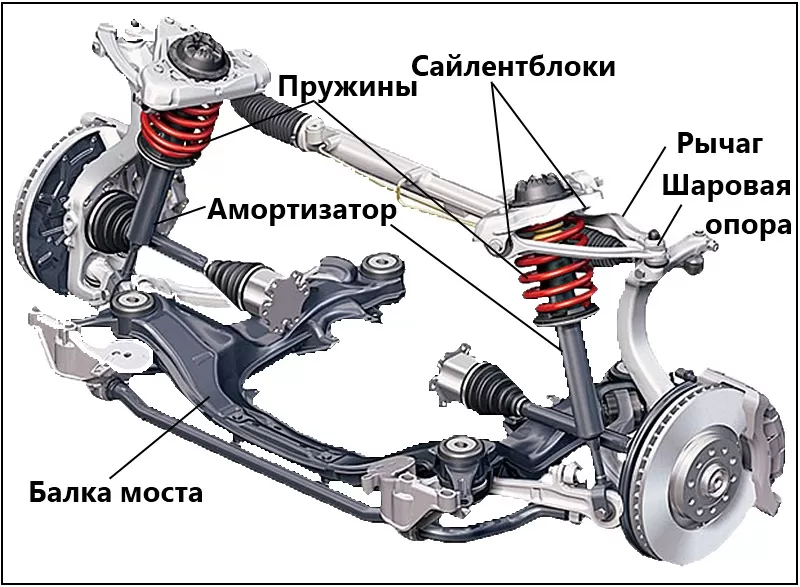
How to take care of the chassis of the car. How to secure it and how to do it. Practical Tips
Content
- Chassis maintenance - why is it important?
- Do-it-yourself chassis repair - is it difficult?
- Anti-corrosion protection of the chassis with grease
- How should maintenance be carried out?
- What should be remembered when caring for the chassis of the car?
- Finally, you need to check the chassis of the car.
- Chassis maintenance agent - what specification should he have?
- Which application method to choose? Gun, brush, aerosol
- Bottom protection is an important issue
Chassis elements such as the exhaust system, brake system or suspension parts are critical to the correct operation of the vehicle. For this reason, it is worth taking care not only of the body, but also of the chassis of the car. Then what should be kept in mind?
Chassis maintenance - why is it important?
Every responsible driver must ensure that maintenance is carried out. A well-maintained chassis will improve driving comfort and the safety of passengers and other road users. It will also reduce the need to visit the workshop and spend money on costly repairs. Regular maintenance prevents many malfunctions.
Underbody protection
For this reason, it is worth taking care of securing the chassis. A protective coating on some components will extend the life of the vehicle and reduce the likelihood of undesirable processes such as corrosion. Rust can ruin even the best car. Factory corrosion protection and other types of protection may not be enough after some time, so it's worth learning how you can do it yourself.
Do-it-yourself chassis repair - is it difficult?
The good news is that taking care of your car and maintaining its individual components yourself is not so difficult. Just stick to the ground rules. Even elementary preventive measures, such as protecting against dirt ingress or affecting the best operation of moving parts, will be a step towards less frequent visits to the service center. What is worth knowing about it?
Anti-corrosion protection of the chassis with grease
One of the best ways to keep your car's chassis, as well as its components, properly protected is to use a lubricant. A good solution is to do this at regular intervals - every 6 months. This will keep all the components below in good working order and give you the best ride quality.
First you need to know which parts to apply lubricant to. Undercarriage protection should cover areas such as:
- torsion;
- steering joint;
- ball joint;
- suspension hinge.
How should maintenance be carried out?
Now that you know which places to protect, you need to move on to how to do it safely. The first step is to access them. A lift will be useful for this. You can also use props or a car pit. Security is key in this context. The next step is to fill the grease gun with the correct undercarriage maintenance lubricant. When you crawl under the car, you should have the car manual handy - for the appropriate model and year of manufacture. Grease should be applied until a small amount of grease begins to drip from the selected component. Thanks to such events, it will be possible to carry out independent repairs of the chassis of the car.
What should be remembered when caring for the chassis of the car?
It should be borne in mind that not all elements in the car - of course, this depends on the model - are equipped with grease fittings. Some suspension pivots and bushings require direct lubrication. For polyurethane components, a mixture containing silicone and alcohol for spraying will suffice. On the other hand, with metal parts, you must first disassemble the elements, apply a specific one to the place of friction, and then reassemble. It is worth remembering that it is necessary to loosen individual elements so that there is access to the lubrication point.
Finally, you need to check the chassis of the car.
Before you take the car off the jack, you should make sure that everything is working properly. For example, during chassis maintenance, you can check to see if any parts need to be replaced. This way you can check for the first signs of wear or cracks.
Chassis maintenance agent - what specification should he have?
There are many undercarriage care products available in stores. Before buying a particular product, you should pay attention to such aspects as, for example, its composition or the method of applying the product - gun, roller, brush.
It is worth paying attention to the description of the goods for the care of the chassis. It should be checked whether the protective layer applied through it will protect the components from salt, stones or water. This is important as moisture can lead to stubborn corrosion spots that are critical to the condition of a vehicle's undercarriage. Bitumen-based lubricants are also available to protect lower vehicle components, e.g. from mechanical damage and provide anti-corrosion protection of the chassis.
Which application method to choose? Gun, brush, aerosol
The most important thing in this case is how to use it. As for the brush, the preparation must be shaken before use. Moreover, it is also necessary to clean the surface on which it will be applied. Only after that a layer of 1,5-2 millimeters is applied to it. The gun is suitable for servicing hard-to-reach places. In the case of using a brush, it is necessary to apply a thicker layer of the drug, from 2 to 4 mm. In addition, you need to leave the car to dry. Waiting time is 5 to 7 hours. This should be done at room temperature 20°C.
Aerosol care products are also available. They are extremely practical. No special equipment is required for their application, and the aerosol itself does not flow or drip. An additional advantage is the short drying time.
Bottom protection is an important issue
It is worth conducting regular inspections of the condition of the chassis of the car. Among other things, components such as the brake system, sills or floor plate. Systematic care of this invisible part of the car can protect parts from corrosion and make them less vulnerable to damage caused by small stones or road salt.
With tools, lubricants, and the right place to lift your vehicle safely, you can clean and maintain your most critical components yourself. If someone finds it too difficult, they can take the car to a professional workshop where the car's chassis will be professionally preserved.

